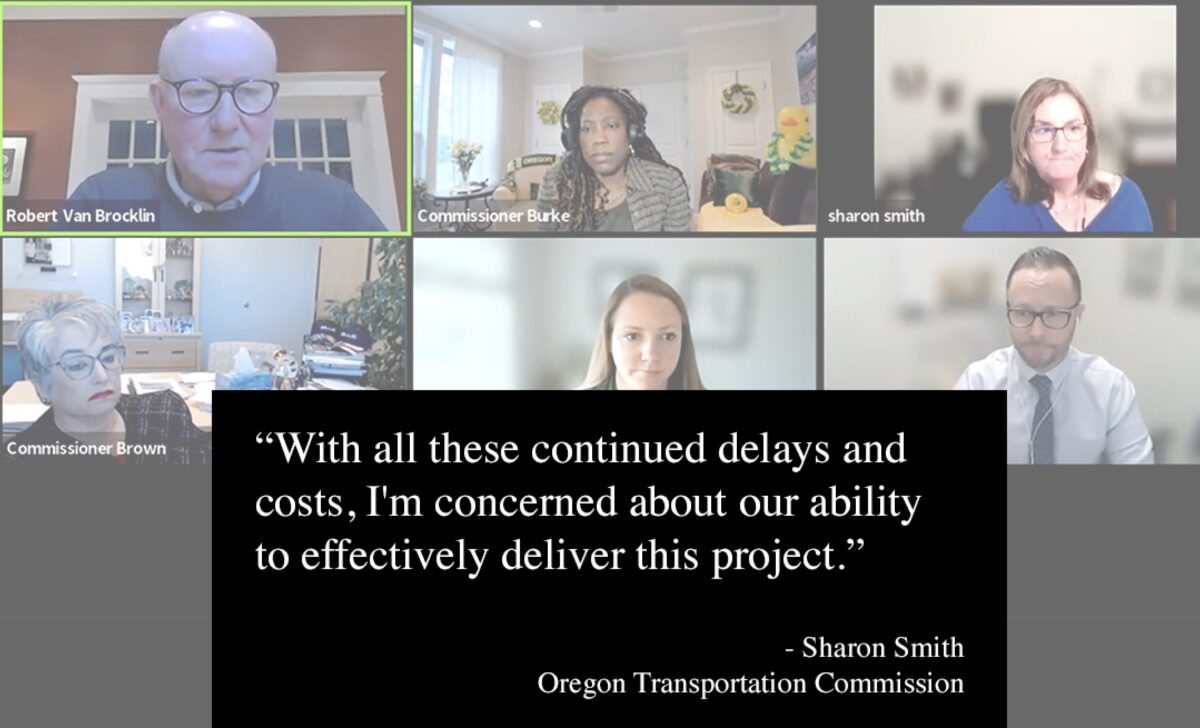
The Oregon Department of Transportation (ODOT) faced a bevy of bad headlines yesterday. The reason? The Federal Highway Administration decided to rescind its previous finding that their I-5 Rose Quarter project had passed its Environmental Assessment (EA) phase. Technically, the FHWA rescinded the project’s all-important “finding of no significant impact” (FONSI), a step required by federal environmental law.
While many people who oppose the project rightfully celebrated this news, ODOT tried to remain calm and reassured their bosses at the Oregon Transportation Commission and the public that it was all expected and that nothing will change. The project director, Megan Channell, even said she was “excited” to re-open the environmental review chapter of the project.
What’s really going on? What does this all mean for ODOT and the project in general? Here’s what we’ve learned:
ODOT downplayed the news
In the opening paragraph of their statement yesterday, ODOT aimed to have people think they decided to update the EA on their own accord. “[ODOT] announced plans,” they wrote, “to develop an updated Environmental Assessment… to reflect the proposed highway cover design supported by the community.”
“We didn’t anticipate the FONSI being rescinded.”
— Tia Williams, ODOT
The FHWA wasn’t even mentioned until the fourth of six paragraphs.
Rose Quarter Project Director Megan Channell said the EA update was, “A step we anticipated.” That’s only partly true. Since the new highway cover design (Hybrid 3) is significantly different than what was previously proposed (see below) and came after the FHWA’s initial FONSI decision, it makes sense ODOT would need to do more analysis.
But ODOT Urban Mobility Office Communications Director Tia Williams told me in a phone interview yesterday that, “We didn’t anticipate, obviously, the FONSI being rescinded… just that some level of environmental review would be needed to accommodate that [Hybrid 3] design.”
ODOT was warned by the FHWA on January 12th that a rescission was being considered.
Advertisement
Six days before the January 18th letter made public by No More Freeways Thursday, FHWA Oregon Division Manager Phillip Ditzler wrote ODOT a separate letter about this issue.
In that letter, which was sent to ODOT Director Kris Strickler with copies to Governor Kate Brown’s transportation policy advisor and the chair of the Oregon Transportation Commission, Ditzler clarified how FHWA would deal with changes pertaining to the Hybrid 3 decision and the related fact that ODOT says the new cover will nearly double the project’s overall cost. (ODOT had sent Ditzler a letter in September 2021 with information about the new cover design.)
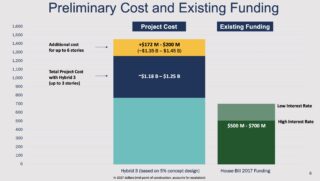
“Based on the information in your [September 30th 2021] letter, it appears that the Hybrid 3 option would make major changes to the Project and therefore at this time, FHWA anticipates that the FONSI will need to be rescinded and further supplementation will be necessary before the Project can advance to final design or construction,” Ditzler wrote. (Aside: Also in that letter, Ditzler revealed that the U.S. Department of Justice and Oregon DOJ have successfully asked for a three-month extension on the No More Freeways lawsuit while this EA update shakes out.)
ODOT is walking a timing tightrope
With the Oregon Legislature and OTC commissioners breathing down their neck waiting for a fix to congestion on I-5, ODOT is desperate to maintain their timeline. There is always a big ticking clock on freeway mega-projects like this one, but it’s even louder these days with record inflation jacking up project costs with each passing week.
In the second sentence of their statement yesterday, ODOT wrote, “The project timeline is still on schedule for construction to begin next year.” At the OTC meeting yesterday, Channell told commissioners ODOT will be “maintaining our construction schedule” and that the additional review “is going to take a few more months”.
We confirmed with Williams yesterday that ODOT expects the review to take 10-12 months and won’t likely be complete by the end of this year. So while ODOT says the project will still break ground in 2023, it will likely be at the very end of that year instead of the beginning.
Advertisement
What changes will be analyzed?
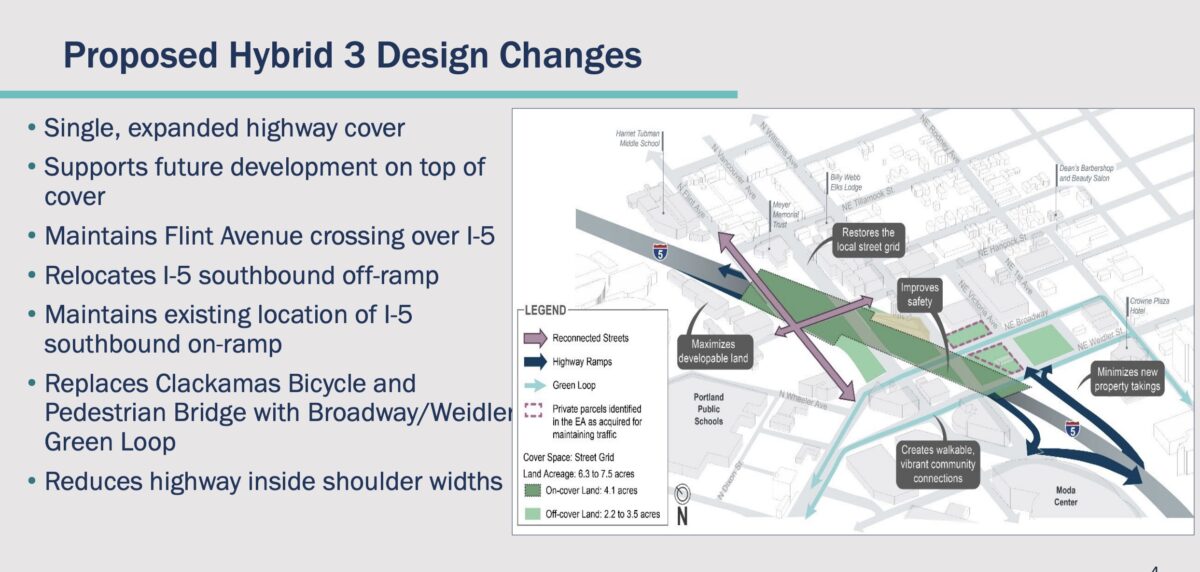
The Hybrid 3 highway cover design will be the focus of this new environmental review. It’s substantially different from previous plans ODOT has put forward and those differences are what will impact the new EA.
As you can see in the slide shared at the OTC meeting yesterday, the new cover is now just one lid instead of two separate ones. That might impact air quality analysis and could push emissions closer to Harriet Tubman Middle School. The plans no longer include a carfree bike/walk bridge at NE Clackamas Way and instead will route non-driving traffic onto the busier and more stressful Broadway-Weidler couplet. This might impact bike and pedestrian traffic modeling.
No new OTC vote, but more public scrutiny
Like I’ve said above, a major reason this FONSI decision is a big deal is because how it impacts the timeline. The longer it takes to move forward, the more expensive it becomes. More time also makes elected leaders nervous and it gives activists more time to organize.
I confirmed with Williams that the EA update won’t require a new vote from the OTC. But she did say ODOT plans to roll out some sort of public process around it. This will give groups like No More Freeways and Sunrise PDX even more opportunities to rally against it and the OTC will hear a lot more public feedback. If past public comment periods are any indication, the vast majority of folks who speak up will be in opposition.
A dreaded EIS still looms
ODOT was relieved to receive approval of the project’s EA from the FHWA in 2020. It meant they could finally stop worrying about the thing they fear most: Being required to do a much more detailed and robust Environmental Impact Statement (EIS). There’s still a chance the pending lawsuit could force one, but barring that, ODOT was free and clear.
Having the FONSI rescinded opens up this possibility once again. Once ODOT completes the EA update later this year, they’ll have to re-submit it to the FHWA. At that point, the FHWA will determine whether or not the project will get another FONSI or if they’ll be required to do an EIS. “If a significant impact can’t be avoided or mitigated,” Williams clarified for me yesterday. “[A requirement do perform an EIS] could be an outcome.”
The delay for this EA update is one thing. Being required to do an EIS would really throw a wrench in the works for ODOT.
With this megaproject the delays, a ballooning budget, public pushback, and myriad controversies are cumulative. And they’ve been piling up for years. That anxiety was evident on the faces and in the words of OTC commissioners on Thursday.
“I have to just be honest,” said OTC Commissioner Sharon Smith at the end of Channell’s presentation yesterday. “With all these continued delays and costs, I’m concerned about our ability to effectively deliver this project. I’m not ready to stop trying, but I just want to express concerns.”
“It’s a large hill, as we all know.” OTC Chair Bob Van Brocklin said in reply, after a deep sigh.


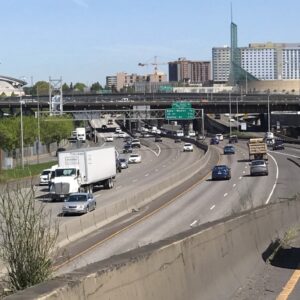


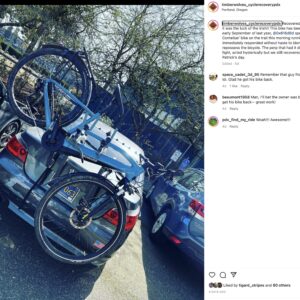
Thanks for reading.
BikePortland has served this community with independent community journalism since 2005. We rely on subscriptions from readers like you to survive. Your financial support is vital in keeping this valuable resource alive and well.
Please subscribe today to strengthen and expand our work.
Through YEARS of this appearing to be a hopeless cause, No More Freeways and Sunrise PDX and Albina Vision persevered and kept the the pressure up. Now the project ODOT is proposing has a continuous cap. The surface street connections and bike/ped amenities are a tone better. The ramp impacts have been reduced. The cap will be develop-able instead of the initially-proposed dead zone. I am in awe of their diligence and I want to applaud their accomplishments. Even if it this project does get built, it has been vastly improved because community pressure dragged ODOT back to the drawing board. Of course, the lane additions are still the bogeyman and should be stopped. There is a better chance of stopping ODOT than I had guessed, but I just want to call out the accomplishments of our local activists!
Agreed! This is a great example of why community outreach and public involvement is so important. If ODOT had been able to just “do the right thing” (in their view) and move forward on their own, none of this progress would have been made.
Completely agree, maxD, and I don’t think the RQ expansion is going to happen. I wish there was some way to reward all of the young activists who have protested ODOT. They have my endless respect.
Don’t give them just respect – also give them money.
Great points all around. And worth remembering when commenters here and elsewhere declare things are “a done deal” and that protesting is a waste of time, or that activists like No More Freeways or Sunrise PDX are “virtue signalling”. They made real and significant change with constant public pressure. When it comes to unelected administrative bureaucracies (which will always be around) this is the only thing that works.
Thank you for making my day with this insightful article, Jonathan. Let’s hope for many more long faces on the part of the OTC as they come to understand that their Trumpy campaigns of manipulation and obfuscation have hit a wall (or a “large hill”), rendering the archaic, wasteful, and morally indefensible RQ and CRC projects unviable. Thanks also to Sharon Smith for reading the tea leaves out loud and allowing doubt to creep in at the highest levels.
It will never be built with The Big One and the Sixth Extinction well on their way. Ten to twenty years at the most say some prognosticators.
Thank you NMF, AVT and Sunrise kids. Lovely seeing Community come together.
We could have done the EIS 4 years ago. I wish ODOT had the courage to hire community leaders from the community to lead these projects.
Instead they are importing paid planner professionals to do the job local planners won’t take on b/c ETHICS.
Megan Channel and ODOT in their response pretty much ignored FHWA finding and seems to think the show will go on. ***Editor: cut a sentence***
ODOT stop gaslighting us. We want to evaluate options in an EIS.
In my former life I spent nearly 20 years writing Environmental Assessments and Environmental Impact Statements for NOAA related to fisheries management actions in the North Pacific. Not the same thing as highway projects, but the law is the same either way. And frankly I have been dumbfounded that ODOT thought that they could get by with an EA for a project this massive. Substantively there isn’t necessarily that much difference between a good EA and an EIS but the review and public comment process is longer with an EIS and doing an EIS brings in other agencies like the EPA into the review process that aren’t involved with an EA.
I expect the original ODOT decision to go with an EA (rather than doing the correct thing and start an EIS From the beginning) will come back to haunt them. The threshold for “significance” for an EIS is $100 million and there is no way they can say with a straight face that this project won’t have more than $100 million of impact on the community. No way.
Now they are trying to double-down on their incorrect decision to proceed with just an EA but this entire process was flawed from the start.
Edit: I think the threshold for significance was raised to $200 million a couple of years ago, but still. My point remains. This is a massively significant project regardless of the merits.
I don’t know enough about the EA/EIS application process, but given ODOT’s quick repsonse that “everything is fine and the schedule won’t be impacted,” is it possible that they anticipated this, and are using it as an opportunity to ditch the lid? Is it possible for them to say that they cannot build the lid because it will cause too much impact?
The covers are a fascinating part of the project. The way it looks to me is that ODOT is simultaneously trying to focus on the lids to distract from the freeway widening, while also trying to pin the cost overruns on “that pesky lid those activists forced us to build” (my quote to paraphrase). It also cannot be stated enough that, despite whether or not ODOT might want to “scrap” the covers due to the cost and complexity they add to the project, politically they can’t do that. Without the covers (which are a stand-in for the support of Albina Vision Trust, the most powerful group in this entire situation), there is no project. As long as AVT says the covers are a must, then so goes the Governor, the Mayor, etc… So ODOT is stuck. They need the covers to get the project done, but the covers are super expensive and might jeopardize the budget.
It’s almost as if we need a bold leader that can stand up and just state the obvious: Let’s pivot away from widening the freeway and find more modern ways to alleviate the bottleneck issues, and focus all our money and attention on mitigating the impacts of the existing freeway with covers and other surface street improvements.
Since I started reading about urban development and bike advocacy (in about 2008), I have become increasingly frustrated with the tactic of using environmental impact statements and public-input tactics to delay and halt good projects, such as renewable energy, multi-family housing, and mass transit projects.
–
So it’s nice to see the EPA regulations put to their originally intended use: stopping/altering a project that does nothing to reduce pollution and sprawl. Furthermore, if I understand the Albina Vision Trust’s role in the matter correctly, the public input process has, so far, obligated ODOT toward a possibly awesome and revitalizing urban building project, that could provide parks and housing. How awesome would that be?!